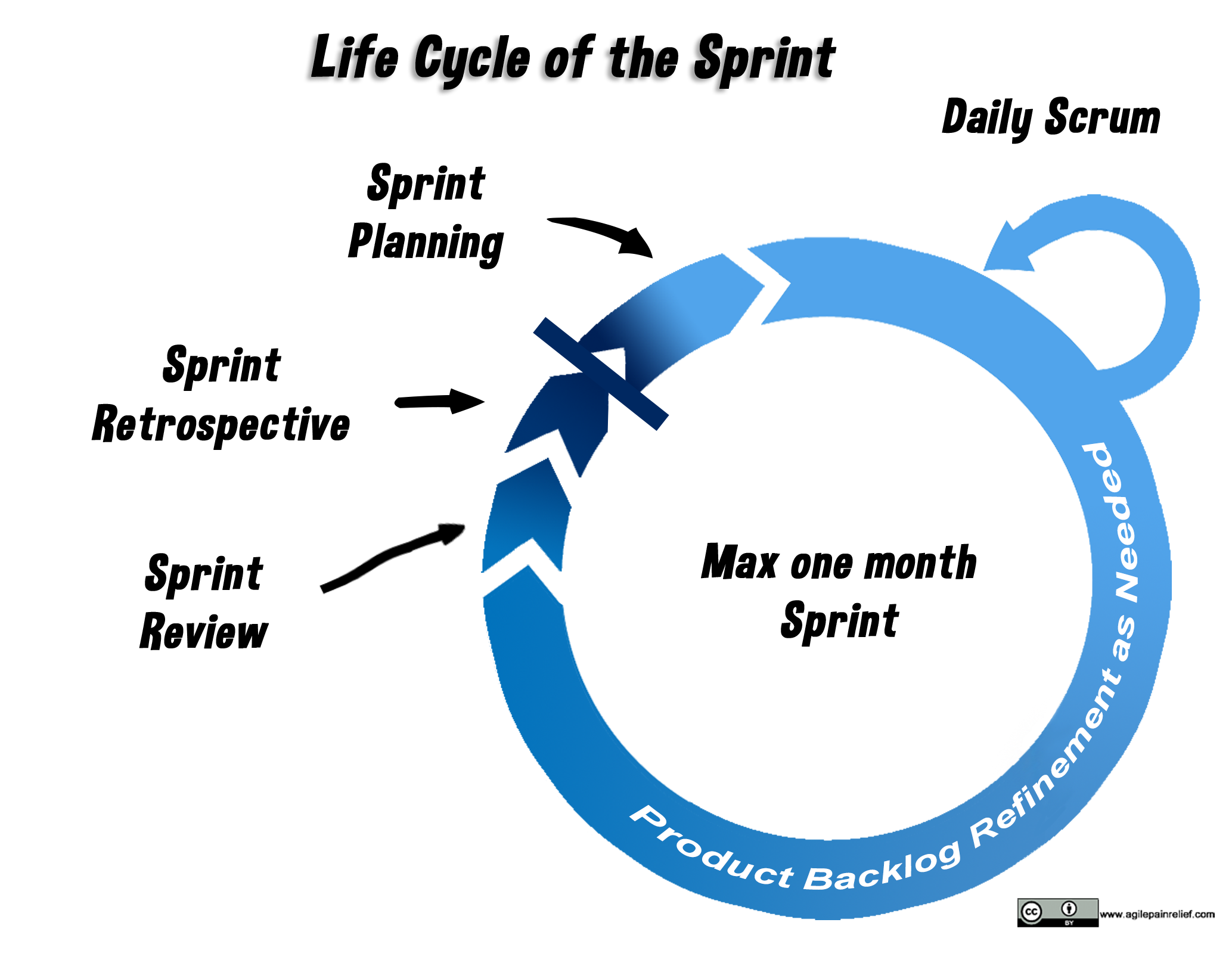- Home
- What Is Scrum? – In a Nutshell
What Is Scrum? – In a Nutshell
You've probably heard the words Agile and Scrum a lot in your professional work life, often interchangeably, and sometimes in reference to things that are neither Agile nor Scrum. Confusing, right?
This is a simple introduction so you know what's what, quickly and easily.

What Is Agile?
Agile is a mindset for doing work in a team environment that improves teamwork, professional performance, and adaptability. The Agile mindset is focused on adapting to changing customer needs while still delivering a high-quality product, and is defined by the values and principles in the Agile Manifesto.
There is no single way to put the Agile mindset into practice, and numerous approaches have been developed. Scrum is currently the world’s most popular approach.
So, Wait, Agile Isn't Scrum?
As you might guess from the different titles here, Agile and Scrum are not the same things. Scrum is an approach to applying the Agile mindset. It provides a lightweight framework to build a product in a way that delivers value to the customer quickly and incrementally, and can adapt if needs change or priorities shift, so you don’t spend months building something only to hand it over and it’s already outdated or not what they wanted any more. Scrum grew up in the world of software development, but it can be used anywhere that individuals need to collaborate as a team to deliver something of value to a customer.
Why Choose the Scrum Approach?
Whole essays have been written on this. Mark discusses in more detail in his blog, but the simplified answer is because it works. Scrum encourages the team to improve on two levels at the same time. First on the product level, by gaining feedback from stakeholders on what is wanted. Second, collecting feedback about the team’s process and the way they work together. The first level allows us to get iteratively closer to the product the customer needs, while the second helps the team grow their skills and teamwork, and focus on delivering quality. Combined, these are very effective toward core Agile goals.

Scrum Terminology
Scrum has a lot of unique terminology and concepts. Here are the main ones you’ll often hear mentioned.
Sprint
A fixed period, ranging from one week to one month in length, during which the Scrum Team works to meet specific customer needs. As one Sprint ends, the next Sprint begins. The purpose of defining the work period is that it enables the Team to focus on a limited and prioritized number of features, and it encourages the delivery of at least some completed work to the customer each Sprint.
Scrum Team
All of the people needed to get the product built and into the customer’s hands:
- ScrumMaster, who helps the team grow capacity to deliver value
- Product Owner, who manages the vision for what they will be creating
- Developers, who are the cross-functional group of people who will build the Product (e.g. in software development this group usually includes programmers, business analysts, quality assurance, user experience and more).
Product Backlog
An ordered list of all the things the Product Owner would like to see the Team work on in the foreseeable future. These items are called Product Backlog Items (PBIs).
User Story*
A tool used to provoke and summarize a conversation, between the Team and their Product Owner, for a better understanding of an item on the Product Backlog. The User Story provides context regarding who a Product Backlog Item is being developed for and why it is of value. * It’s important to note that this isn’t part of Scrum per se, but is a tool that grew up beside Scrum and is often used in conjunction. User Stories can be helpful but aren’t required as part of the practice of Scrum.
Sprint Planning
An event at the beginning of a Sprint where the Team plans the items they can complete in the next Sprint. They also craft a goal to act as a focus for their work.
Sprint Goal
A single objective shared by the Team that describes the purpose of the Sprint and ensures that everyone moves in the same direction. A simply-stated goal makes it easier to prioritize Product Backlog Items, assess whether tests and feedback are relevant to the goal, and summarize the work currently being done when asked by stakeholders.
Product Backlog Refinement
A session during which the Scrum Team (Developers, Product Owner, ScrumMaster) prepare the Product Backlog for the next few sprints. New Product Backlog Items (PBIs) are added for new needs to be considered. PBIs that are too large to be worked on in a single Sprint are broken down into smaller items. Estimates are made as to how much time each PBI will require to complete. The Product Owner makes prioritization decisions about PBIs, sharing with the Team their reasoning.
Sprint Backlog
The list of Product Backlog Items (PBIs) the Team has committed to for the next Sprint.
Daily Scrum
The daily meeting where the Scrum Team get ready to collaborate for the day, and check if they’re still on track to complete their goal forecast by the end of the Sprint.
Definition of Done
The official checklist that Scrum Teams maintain of the qualities they intend their work to achieve. It helps the team assess whether their work is truly completed and deliverable to the client as having added value. It also helps them in Sprint Planning by reminding them of the quality they have committed to achieving, ensuring they only commit to PBIs they can get to truly “Done.”
Sprint Review
An event at the end of the Sprint where the Scrum Team review the completed work with stakeholders. Stakeholders provide feedback on the completed work and ideas for product improvements. The Product Backlog will get updated during future refinement to reflect what everyone learned.
Sprint Retrospective
An event at the end of the Sprint where the Scrum Team reflects on all that happened in that period, with the intention to improve how they work in the next Sprint.
That is Agile and Scrum forced into a ridiculously small nutshell. You can spend years learning and understanding the many nuances, and how to get the greatest benefits out of them. If you’d like to take the first step and build a solid foundational understanding of the how and why of Scrum, and not just the what that you can learn from reading summary pages like this, join us in our training workshops. You will actually practice Scrum and learn how to make it work for you in the real world, rather than just in theory.
Your Guide to Everything Scrum
Mark Levison spent 12 years as a ScrumMaster and Coach, helping teams by chance before he started to systemize it. Armed with an insatiable love for research, he has been studying and teaching Agile since 2001, introducing Scrum, Lean, and Agile methodology to a broad range of individuals and organizations. Mark has helped launch Scrum practice throughout Canada including Government of Canada departments, major financial and insurance institutions, healthcare agencies, and leading payroll, HR services, and software companies.
Students and communities benefit from Mark’s more than thirty years of experience in the IT industry and over two decades of Scrum and Agile expertise, as he brings his uniquely fun and effective teaching style to thousands of individuals and teams so they can be more effective.
Get Certified
Explore what Scrum is and how to make it work for you in our Scrum Certification training. Hands-on learning will guide you to improve teamwork, deliver quick feedback, and achieve better products and results.
Registration is now open for workshops:
About this course
Focuses on the role of the team and the ScrumMaster. Get the skills and practical experience necessary to improve teamwork, take the exam, and advance your career with a certification that is in high demand today. Often the best fit for anyone new to Scrum.
Learning and Benefits
Relatable Scenarios
Learn on-the-job applications of key Scrum concepts, skills, principles, along with practical solutions that you can apply the next day for difficult, real-life situations.
Respected Certification
Everything you need to earn your Scrum Alliance® ScrumMaster certification, including exam fee and membership, and so much more.
Practical Exercises
With focus on the challenges that real teams face, and tools to dig deeper. You don’t need more boring Scrum theory. You need something you can sink your teeth into to see immediate results.
Jargon-Free Learning
This workshop is not just for software development or people with a computer science degree. We’ve helped many non-software teams with Scrum.
Career Advancement
Use Scrum knowledge to standout at work, get paid more, and impress your customer, all without burning out.
Ongoing Support
Our active Scrum community forum is a safe place to ask questions. Long after you earn the Certified Scrum Master certification, you will have access to the forum, course materials, and additional valuable resources.
